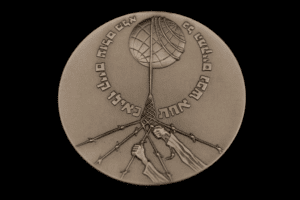Gregory Rutecki
Lyndhurst, Ohio, United States

CC BY-SA 4.0
Michael Litynski M.D. was born in 1906 in Lodz, Poland. As a physician during World War II, he joined the Polish Resistance. He treated resistance fighters and was active during the infamous Warsaw Uprising in 1945. Dr. Litynski was also awarded the Yad Vashem medal for his brave efforts on behalf of Polish Jews.1 His post-WWII efforts addressed the adrenal gland.
In 1953 he reported in a Polish journal two male patients with hypertension who at autopsy had cortical adrenal tumors localized to the adrenal glomerulosa.2 Both patients died of malignant hypertension with consequent renal failure. He correctly surmised that these tumors produced mineralocorticoids responsible for the patients’ hypertension.2,3 He also correctly contrasted his patients with other individuals exhibiting Cushing Disease, verifying that primary aldosteronism was a distinct adrenal disease. In his own words, translated from Polish:
“It must be assumed that in both cases the hypertension was was caused by adrenocortical tumours, unilateral in one case and right-sided (sic) in the other case. The histology of the tumours revealed proliferation of cells resembling cells of the glomerular layer, i.e. the mineralocorticoid-producing layer. It allows us to believe that we were dealing with was excessive production of these hormones.”2
Litynski’s discovery preceded that of Conn by two years.4 It was published in the aftermath of the Second World War World and during the Cold War in a journal that would not have been easily accessed in the West and was not translated for years.3 In 1983 and 1984, two individuals discovered his contribution and sponsored a proposal to rename the syndrome “Litynski-Conn Syndrome.”3,5 Litynski’s precedence and that proposal were recognized in the Lancet and in Norman Kaplan’s “Clinical Hypertension” textbook.3,6 So far, Dr. Litynski’s recognition has not been forthcoming. But considering the circumstances when he published his observations it is perhaps understandable. At a time when the eponymous naming of diseases has become less popular, it may be sufficient to know that indeed it was Michael Litynski who first noted the association between hypertension and mineralocorticoid producing adrenal tumors.
References
- Kucharz E.J. Forgotten description of primary hyperaldosteronism. Lancet 1991; 337:1490.
- Litynski M. Nadcisnienie tetnicze wywolane guzami korowo-nadnerczowymi. Pol. Tyg. Lek. 1953; 8:204-2.
- Mysliwiec J and Gorska M. Primary aldosteronism: a common and important problem: A practical guide to the diagnosis and treatment. Polish Journal of Endocrinology 2012; 63:324-336.
- Conn J.W. Primary aldosteronism: a new clinical syndrome. J. Lab Clin. Med. 1955; 43:3-17.
- Marcinkowski T. Conn’s syndrome or Litynski-Conn syndrome? Mat. Med. Pol. 1992; 24:126-127.
- Kaplan N.M. Kaplan’s Clinical Hypertension. Lippincott, Williams and Wilkins, Philadelphia, 2002.
GREGORY W. RUTECKI, MD, received his medical degree from the University of Illinois, Chicago in 1974. He completed Internal Medicine training at the Ohio State University Medical Center (1978) and his fellowship in Nephrology at the University of Minnesota (1980). After twelve years of private practice in general nephrology, he entered a teaching career at the Northeastern Ohio Universities College of Medicine, the Feinberg School of Medicine, Northwestern University, and the University of South Alabama in Mobile, Alabama. While at Northwestern, he was the E. Stephen Kurtides Chair of Medical Education. He now practices general internal medicine at the Cleveland Clinic.

Leave a Reply